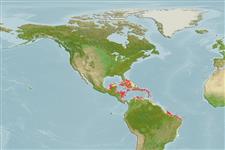Environment: milieu / climate zone / depth range / distribution range
Écologie
marin récifal. Tropical; 27°N -
Western Atlantic: Bahamas and Central America to northern South America.
Taille / Poids / Âge
Maturity: Lm ? range ? - ? cm
Max length : 5.0 cm TL mâle / non sexé; (Ref. 9710)
Dark green, with 17-23 pale green bars. Brownish stripe through eye interrupted by bright red spot.
Inhabits pitted limestone faces and tide pools in surf areas in clear waters. Usually found among spines of rock-boring sea urchins (Ref. 26938). A protogynous hermaphrodite (Ref. 55367). Has been reared in captivity (Ref. 35420).
Life cycle and mating behavior
Maturité | Reproduction | Frai | Œufs | Fécondité | Larves
Benthic spawner. A monandric species (Ref. 55367). Sex reversal is completed in 3-5 weeks (Ref. 34185, 31410). Length at sex change = 2.0 cm TL (Ref. 55367). Males have a unique paired, secretory, accessory gonadal structures (AGS) associated with the testis (Ref. 103904).
Robins, C.R. and G.C. Ray, 1986. A field guide to Atlantic coast fishes of North America. Houghton Mifflin Company, Boston, U.S.A. 354 p. (Ref. 7251)
Statut dans la liste rouge de l'IUCN (Ref. 130435: Version 2024-1)
Menace pour l'homme
Harmless
Utilisations par l'homme
Pêcheries: commercial; Aquarium: Commercial
Outils
Articles particuliers
Télécharger en XML
Sources Internet
Estimates based on models
Preferred temperature (Ref.
123201): 26.8 - 28.2, mean 27.6 °C (based on 493 cells).
Phylogenetic diversity index (Ref.
82804): PD
50 = 0.5000 [Uniqueness, from 0.5 = low to 2.0 = high].
Bayesian length-weight: a=0.00724 (0.00339 - 0.01546), b=3.10 (2.92 - 3.28), in cm total length, based on LWR estimates for this (Sub)family-body shape (Ref.
93245).
Niveau trophique (Ref.
69278): 3.2 ±0.3 se; based on size and trophs of closest relatives
Résilience (Ref.
120179): Haut, temps minimum de doublement de population inférieur à 15 mois (Preliminary K or Fecundity.).
Fishing Vulnerability (Ref.
59153): Low vulnerability (10 of 100).
